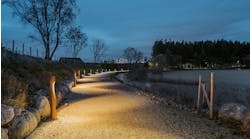"Wall base is almost like a lost soul once it's installed. It takes the abuse of vacuum cleaners bumping it, people kicking it, and carts running into it. And in most applications, it gets very little maintenance or care. Nobody pays much attention to it ... at least not until it fails to live up to expectations."
Jonathan Barton is speaking from years of experience. As director of flooring for a commercial flooring company in Austin, Texas,* he's worked on hundreds of projects and knows that the type of wall base specified does indeed make a difference—in the appearance, performance, and the life-cycle costs of the project.
Wall Base for Every Occassion
"Our project managers—I was one once myself—will always give our clients the best options we can in wall base and other materials," says Barton. "I'd say rubber is definitely the premium choice over vinyl or vinyl-rubber blends because it offers more LEED® certification advantages, is more installer-friendly, and doesn't shrink over time."
Of course, there are other differences between rubber, vinyl-rubber blends, and vinyl wall base—cost being one of them. Vinyl is the least expensive, rubber is the most.
More handpicked content to read:
"If a client absolutely needs to hit a lower price point, we'll show them vinyl or a vinyl-rubber mix," adds Barton. "But project specifiers who want to put quality above everything else choose a 100 percent rubber wall base. The Dell Children's Medical Center in Austin took this approach, and it is on track to be the first Platinum LEED-certified building of that kind in the nation."
As a specifier, you want to know you're getting what you and your client have asked for (particularly where the phrase "or equal" is used), so it's important to understand the differences between a 100 percent rubber wall base and vinyl-rubber blends. There have been instances where a blended product was sold as rubber, and specifiers were surprised when what they thought was 100 percent rubber didn't deliver the benefits they were expecting.
The following is a rundown of the major differences between wall base materials. These differences are spelled out in great detail in the ASTM F-1861 Standard Specification for Resilient Wall Base. (Details of the standard beyond material classifications are summarized in the sidebar below).
THERMOSET VULCANIZED RUBBER (TS)
Thermoset rubber cove base production begins with raw rubber—typically synthetic, although some manufacturers also add a percentage of natural rubber—and virgin fillers and additives necessary to produce the color and other desirable attributes of the product. These ingredients are mixed to achieve a homogeneous blend ready for further processing. This blend is extruded or molded to the desired shape, size, and length, and the formed portion is then vulcanized under heat and pressure. The vulcanization process is what really distinguishes thermoset cove base from the other types.
Its color is homogenous throughout the base (ASTM F-1861, Group 1), so nicks or gouges have little visual affect on the installation. Further, its low-gloss satin finish resists scuffing and wards off negative effects from chemicals, making it easy to maintain throughout its installed life. With an expected longevity of 10 to 15 years, lower maintenance requirements mean savings for your client and a project that looks better longer.
Type TS is made from 100 percent rubber, so it's extremely flexible and easy to install. Inside corners are easily mitered and outside corners can be formed and wrapped at installation. TS will not shrink or cup; is less prone
to distortion when exposed to heat; and its 1/8-inch thickness helps to hide wall imperfections. It is also generally offered in the greatest range of profiles and heights: ½-inch increments from 2½ to 6 inches.
TS contains no PVCs and will not emit vinyl chloride, plasticizers, asbestos, or CFCs. And because it contains 10 percent natural rubber, it offers advantages for projects striving for LEED certification.
THERMOPLASTIC RUBBER (TR) AND THERMOPLASTIC VINYL (TV)
Thermoplastic rubber and thermoplastic vinyl cove bases are manufactured essentially in the same way. The raw materials are introduced to the extruder, where the blending and forming processes take place at a temperature high enough to lower the viscosity of the compound so it can be formed into the desired shapes. This mixture is then extruded or molded and cooled to produce the final product. Because they are not vulcanized, these products can be reshaped by the reintroduction of high temperatures.
TPR is the "middle-of-the-road" choice. Like TS, its 1/8-inch thickness hides wall imperfections, and its base color is often slightly lighter than its wear-layer color. This allows for more visibility when gouges or nicks are present in an installation. Its top lip design helps it fit snugly against the wall.
Most TPR wall base is 92 percent to 98 percent vinyl, and is manufactured in either a two-part method (wear and core layers) or homogeneously. It requires at least a 24-hour acclimation period on-site, uncoiled, and is known to have shrinkage issues over time. As a specifier you need to be aware of these and other significant differences between TPR and TS when you're looking for a real rubber wall base.
Type TV, the lowest cost wall base is made almost entirely of PVC. Its construction consists of a colored wear-resistant top layer over a lighter color core (ASTM F-1861, Group 2), so gouges and nicks are more visible. It is
generally available in two thicknesses: 0.080 and 1/8-inch. The thinner version can telegraph wall irregularities and is more prone to shrinkage. Like TPR, type TV also has a top lip design that fits snugly against the wall.
Both types, TPR and TV, are more difficult to handle and install than type TS. Cutting requires more effort, and forming corners often results in visible white stress lines or discoloration in the material.
"We do our best to make sure our clients understand the differences in these products," explains Barton. "Our first job is to help them meet their goals, whether it's a certain LEED certification or a certain price point. But when they know the details of how well rubber performs over the other options, many start thinking more about the long-term value they can bring to their project than the initial price point."
Kenn Busch has been writing about and photographing furniture and interior design for publications in North America, Europe, Asia and China since 1990. Based in Madison, WI.
FRESH Acoustics 101 Series: Part 1 / Part 2 / Part 3 / Part 4 / Part 5 / Part 6 / Part 7
ASTM F-1861 is a more up-to-date classification system than the standards that preceded it; and by implementing it, manufacturers are ensured that customers get exactly what they specify — i.e., they receive a product of similar quality when "or equal" is stated.
The standard, however, goes well beyond just establishing the classifications. For instance, it establishes three types as well as two groups of cove base:
-
Type TS—rubber, vulcanized thermoset
-
Type TPR—rubber, thermoplastic
-
Type TV—vinyl, thermoplastic
-
Cove Base, Group 1:
Solid (homogenous)—"The color shall be uniform throughout the entire thickness of the wall base." - Cove Base, Group 2:
Layered (multiple layers)—"The surface color need not extend through the entire thickness of the wall base, but must extend throughout the entire wear layer." In addition, the layered wall base "shall have a minimum wear-layer thickness of 0.002 inches and shall not delaminate under normal use."
Three styles of cove base are specified:
- STRAIGHT WALL BASE—"The exposed surface of straight (toeless) wall base is vertical."
- COVE WALL BASE—"The exposed surface of cove wall base shall be distinguished by a ‘toe' at its bottom edge." The toe can be curved, angled, or both, to fit snugly on top of the floor when the vertical portion of the cove base is adhered to the wall. The intersection of the exposed surfaces of the toe and the vertical portion of the cove base need to be rounded and smooth to facilitate maintenance.
- BUTT-TO-WALL BASE—"The exposed surface of butt-to wall base shall be distinguished by a ‘toe' that butts against the flooring." The leading edge of the toe is square to allow a tight, flush fit. The intersection of the exposed surfaces of the two and the vertical portion "shall be designed to facilitate maintenance."
ASTM F-1861 also provides corner specifications: corners must be the same height and thickness as the wall base. Specifiers, however, should consult the manufacturer to ensure color acceptability between factory-made corners and wall base prior to ordering, as factory-made corners and wall base may have visual color differences due to process and material variations.
When properly formed and fitted by the installer on the job, however, outside corners are acceptable and it is not necessary to specify preformed or pre-molded corners. Instructions to help the installer form acceptable corners on the job can be obtained from most manufacturers.
Cove base is commonly available in 2½ inches, 4 inches and 6 inches. Several manufacturers have introduced new heights of wall base designed to cover any wall blemishes, such as adhesive lines and paint and wallpaper damage, which may occur from removing old cove base. In such a situation you should consider using a 4½-inch base to replace a 4-inch base and a 3- or 3½-inch base to replace a 2½-inch base. These additional heights are extremely helpful for remodeling and are often used when replacing a thicker floor with a thinner one. (The wall base will move down, so you need a higher base to meet up with the wall covering.)
Typically, cove base is packaged 120-feet per carton in four-foot sections. Continuous 120-foot rolls, however, are available from most manufacturers, which allow for more seamless installations and cleaner aesthetics.
When specifying colors, manufacturers should be contacted to verify color acceptability. Note that for solid (homogeneous) wall base, the color should be uniform throughout the entire thickness. For layered wall base, the surface color does not need to extend through the entire thickness of the wall base, but must extend through the entire wear layer, which should be a minimum of 0.002-inch thick.
PERFORMANCE REQUIREMENTS
In establishing the cove base standard, ASTM provided testing methods to ensure that products meet certain requirements. At issue are flexibility, staining of adjacent surfaces induced by wall base, resistance to light, resistance to chemicals, and dimensional stability. In addition, the standard calls for the wall base to "be free of defects, which adversely affect performance or appearance, such as blemishes, spots, lines, indentations, blisters, and delamination." Also, unless otherwise specified, the "back or bonding surface of the wall base shall be buffed, roughened, ribbed, grooved, or otherwise modified to improve the application to and adhesion to the wall surface; but in no case shall the thickness of the wall base be decreased to the extent that any depression or groove on the bonding surface be perceptible, under any circumstances, on the exposed surface."
Flexibility. Under ASTM Test Method F137 cove base is tested for flexibility. A sample is placed right-side out over a cylindrical mandrel and then bent around the mandrel. The product passes the test if it shows no visible cracks, breaks or other evidence of weakness. The test is then repeated with the sample faced against the mandrel. Flexibility is important when wrapping corners. And more flexibility means less possibility for cracking or discoloration at corners.
Staining of adjacent surfaces induced by wall base. To provide for long-term customer satisfaction, specifiers seek cove base that will not stain adjacent surfaces. "The wall base shall contain no ingredient that will cause staining of the finished surfaces adjacent to it," according to standard F 1861, section 11.1-11.7. This test involves placing two wall base specimens on the painted surface then covering the wall base specimens with a second metal panel so that the painted surfaces are sandwiched between and touching both metal panels. This assembly is then heated in an oven (approximately 158 Fahrenheit for a period of approximately 166 hours). Simultaneously, a control panel without the wall base is tested. Any staining of the sandwich panel (beyond the specimen location greater than the discoloration of the control panel) is considered migration staining and objectionable.
Resistance to light. Test Method F1515 measures where a floor covering changes color from exposure to light over a specified period of time. In other words, greater light resistance means greater resistance to premature aging. The test will confirm that the color change of the wall base has an average Sigma-Delta (ΣΔ) no greater than 8.0 after 200 hours of exposure to light, simulated by a properly fitted xenon-arch radiant energy source. Check with the manufacturer for products recommended for use in entryways or other installations exposed to direct sunlight.
Resistance to chemicals. Accordance with Test Method F 925 ensures that the wall base has no more than a slight change in surface dulling, surface attack, or staining when exposed to the following chemicals:
- White vinegar (5 percent acetic acid)
- Rubbing alcohol (70 percent isotropy alcohol)
- Sodium hydroxide solution (5 percent NaOH)
- Hydrochloric acid solution (5 percent HCl)
- Sulfuric acid solution (5 percent H2SO4)
- Household ammonia solution (5 percent NH4OH)
- Household bleach solution (5.25 percent NaOCl).
- Olive oil (light)
- Kerosene (K1)
- Unleaded gasoline (regular grade).
The test calls for cove base samples to be exposed to these agents for approximately one minute. Samples should be checked five minutes after removing the potentially polluting agents. Check with the manufacturer for specific stain test results.
Dimensional stability. This test, referenced in section 11.8-11.15, measures the changes in linear dimensions of wall base resulting from exposure to a specific amount of heat over a specific amount of time (approximately 180 degrees F for approximately six hours). Wall base should not change in length by more than 0.25 percent. Greater dimensional stability means less shrinkage, which means fewer gaps. Some products perform better in certain climates with large temperature changes.
After reading this article, you should be able to:
-
Understand the differences between the three main types of resilient wall base.
-
Explain which wall base materials will require the least maintenance in high-traffic applications.
-
Understand the basics of ASTM F-1861 Standard Specification for Resilient Wall Base.



